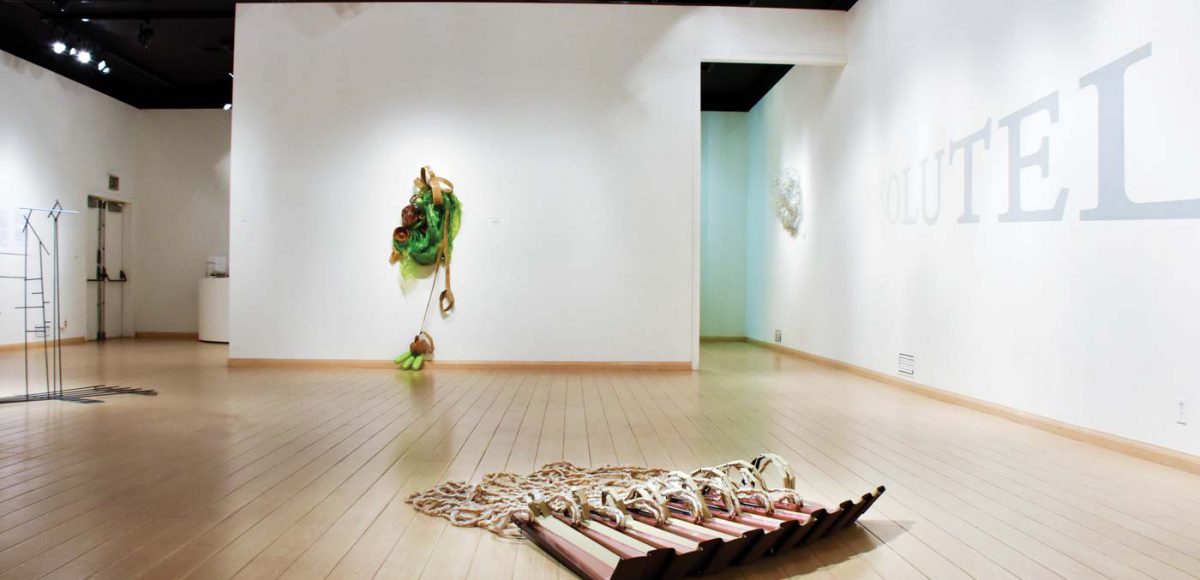September 21, 2017–December 7, 2017
Jacques Derrida deconstructed Plato’s concept of khôra, stating, “One cannot even say of it that it is neither this nor that or that it is both this and that.” If that sounds perfectly unclear, that is the point. In ancient Greece, khôra was originally a geographic area outside the city center, an “other” place. The term implies a space between being and not being, a location where new ideas can emerge. As such, Khôra is appropriately titled. Curated by Fatemeh Burnes and featuring work by John David O’Brien, Rebecca Ripple and Coleen Sterritt, Khôra circumvents logic in delightful ways. It is an intellectually stimulating and conceptually grounded exhibition that occupies a quiet space, perfect for discovery.
Rapunzel (2009) by Rebecca Ripple is a low-to-the-ground object composed of industrial metal awning with lustrous pink resin and shrink-wrapped gold cord macramé, trailing across the floor in fairytale fashion. A multitude of references come to mind, from Marcel Duchamp’s readymades to Eva Hesse’s Post-Minimal rope pieces, to Southern California Finish/Fetish. Absurdly, neither the awning nor the “hair” are in their expected lofty positions, but instead lie prone on the floor. Fid 2 (2013) is a mesmerizing wall-mounted fractal-like nest of galvanized wire and tabs of masking tape. Along with its cast shadows, this work makes a huge visual impact with very little, much like Arte Povera but glitzier. Dominating one entire wall is Ripple’s painted text, Absolutely (2008), which employs atmospheric and linear perspective. If one stands to the far left, the perspective is canceled out and each letter appears to be the same size. Although flat, Ripple has paradoxically managed to make Absolutely a three-dimensional experience, inviting viewers to approach it as sculpture.

John David O’Brien, Rebecca Ripple, Coleen Sterritt: Khôra.
Installation View at Mt. San Antonio College Art Gallery.
Coleen Sterritt’s Green Rondo à la Turk (2015) references the Dave Brubeck composition Blue Rondo à la Turk (1959), which merged American blues with Turkish rhythms. This hybridization manifests in Sterritt’s work by merging sculpture with painting aesthetics. It is wall-mounted at eye-level like a picture, with dangling parts that rest on the floor. Color, the domain of painting, is essential to this sculpture, whose palette of greens and browns is suggestive of landscape. The machine-made plastic and foam rubber materials are at odds with the natural wood and sea sponges, creating a contrast that supports the exhibition’s theme. Vixen (2013) is also green—a mossy green combined with recycled bentwood furniture pieces to evoke rhythmically organic tendrils or perhaps Medusa herself. Remnants of rattan, presumably from bentwood chair seats, twist around parts of the sculpture while upturned shelving units serve as receptacles for something unknown. The piece is whimsical, elegant but rustic, abstract yet suggestive.
AO scultura-5 (koan) (no date) is a sophisticated black linear sculpture by John David O’Brien. Between four and five feet tall, its scale is modest but nearly human, inviting intimate encounter. In Zen Buddhism a koan is a type of story or riddle meant to puzzle the mind and disrupt logical thinking, hopefully leading to a state of enlightenment. As one views this sculpture from all angles, its appearance changes drastically, with no single vantage point offering a definitive view. Like the best minimalist sculptures, O’Brien’s work transcends the physical, becoming a temporal experience. A group of four framed mixed-media works entitled trame (2015) utilize mapping to create richly textured, tapestry-like compositions that invite viewers to decipher the embedded information. The artist was born in Japan, has spent a considerable amount of time living and working in Italy, has resided on the East Coast and is based in Los Angeles. These locations are not merely “plots” (“trame” in Italian) but rather personal memories and experiences. The layered combination of drawing, printing, cutting, painting, photography and laser-cut metal further suggest multiple meanings, making these works much more than the sum of their parts.









